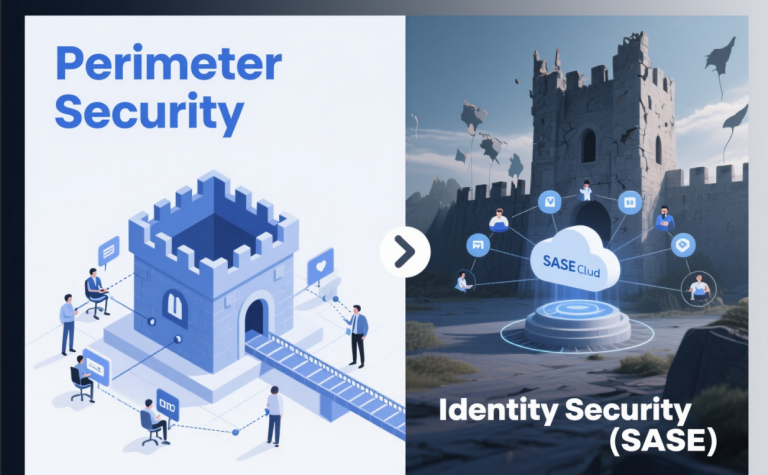
Take a walk through your corporate office on a Tuesday afternoon. It’s quiet. A few people are gathered in a conference room, but the rows of desks that once buzzed with activity are now largely empty. Yet, down in the server room, the heart of your security infrastructure is still humming along—a fortress of expensive firewall appliances, intrusion prevention systems, and web gateways.
You’ve spent a fortune building and maintaining these walls. But where are the people you’re trying to protect?
They’re at home, logging in from their kitchen tables. They’re in coffee shops, accessing company data between sips of a latte. They are connecting directly to cloud applications like Salesforce and Office 365, their traffic never once passing through your magnificent, and now mostly irrelevant, corporate firewall.
The perimeter, that clear, comforting line between the “trusted” internal network and the “untrusted” internet, is gone. It hasn’t just been breached; it has dissolved into thin air. It has become a ghost. And if you’re still spending your time and budget guarding a ghost, your business itself is in peril.
The hybrid work era isn’t a temporary trend; it is the new permanent reality. This seismic shift has fundamentally broken the old security model. It demands a new way of thinking—a new architecture that is no longer built around protecting a place, but is designed from the ground up to protect your people and your data, no matter where they are.
Today, we’re going to step outside the walls of that empty fortress. We will explore the forces that caused the perimeter to dissolve and introduce the new, agile, and identity-centric security blueprint that is rising to take its place. This isn’t about reacting to a crisis; it’s about embracing the future of work and building a business that is as secure as it is flexible.
Chapter 1: The Ghost of the Perimeter - Why the Castle-and-Moat Has Crumbled
For decades, we built our security like a medieval fortress city.
The Castle: Your corporate headquarters and its on-premise data center.
The Moat & Walls: Your corporate firewall.
The Citizens: Your employees, safely inside the walls, connected by wires to the “trusted” local area network (LAN).
The Outside World: The dangerous, untrusted internet.
The logic was simple: build an impenetrable wall to keep the bad guys out. Anyone who made it inside was, by definition, a trusted citizen. This “castle-and-moat” model worked beautifully for a world that no longer exists. Three unstoppable forces have conspired to turn this once-mighty fortress into a historical relic.
Force #1: The Cloud Migration (The Critical Services Moved Out)
The first force was the mass exodus of our most important services to the cloud. Your company’s crown jewels are no longer stored in the castle’s keep.
Your customer data is in Salesforce (a SaaS cloud).
Your company’s documents and emails are in Office 365 or Google Workspace (a SaaS cloud).
Your own custom applications are likely running on AWS or Azure (an IaaS/PaaS cloud).
Now, consider the absurdity of the old model in this new reality. A remote employee, working from home, needs to access Salesforce. In the castle-and-moat world, they must first connect via a slow, clunky VPN (Virtual Private Network), tunneling through your corporate firewall, just to then be sent right back out to the internet to access Salesforce’s cloud.
This is a practice known as “hairpinning” or “backhauling,” and it’s a performance killer. You are forcing your citizens to make a long, pointless detour through the old, congested castle gates to visit a new, modern marketplace that exists entirely outside the castle walls. It’s inefficient, it creates a terrible user experience, and it makes no logical sense.
Force #2: The Hybrid Workforce (The Citizens Moved Out)
The second force was the great dispersal of your people. The pandemic was the catalyst, but the hybrid work model is the permanent outcome. Your employees—your “citizens”—are now everywhere.
Their home office is their primary office. Their local coffee shop is their conference room. This means the new corporate network is, in fact, the wild, untamed public internet. The concept of a trusted “inside” zone has vanished. Every user is now an “outside” user, all the time. Attempting to secure this distributed workforce by forcing everyone through a single, centralized firewall is like trying to protect a global empire from a single guard post.
Force #3: The Rise of BYOD (The Citizens Have Their Own Vehicles)
The final force was the blurring of lines between personal and work devices. Employees now access sensitive corporate data using their personal laptops, tablets, and smartphones (Bring Your Own Device).
You have no control over these devices. You don’t know if their operating system is patched, if they have antivirus software, or if they are riddled with malware from a child’s gaming downloads. A trusted user on a compromised personal device is one of the most dangerous threat vectors in the modern world. It’s an enemy agent driving a trusted citizen’s car right through the main gate.
The walls have dissolved. The citizens are scattered. The vehicles are unknown. The old model is broken. We need a new blueprint.
Chapter 2: The New Blueprint - From Protecting a Place to Securing a Connection
The fundamental flaw of the old model was that it granted trust based on location. If you were “inside” the network, you were trusted.
The new model, born out of the necessities of the hybrid work era, is built on a radically different and simpler philosophy: trust is never granted based on location. The network is always assumed to be hostile. Trust is only granted, on a per-session basis, to a specific connection.
This philosophy has a name: Zero Trust. And its architectural manifestation, designed specifically for the modern, distributed workforce, is called SASE (Secure Access Service Edge).
What is SASE, in Plain English?
Don’t let the acronym intimidate you. SASE (pronounced “sassy”) is not a single product. It is a new architectural approach, an elegant convergence of what used to be two separate worlds: networking and security.
The Old Way: You would buy a dozen different products from a dozen different vendors. You’d have a hardware firewall, a VPN concentrator, a secure web gateway, a cloud security broker, a WAN optimization appliance… a complex, expensive, and fragmented mess of boxes and software.
The SASE Way: SASE takes all of those functions and delivers them as a single, unified, cloud-native service. Instead of building your security at your data center (the old castle), you subscribe to a security service that is delivered from the cloud and lives at the “edge,” as close to your users as possible, wherever they may be.
It’s a shift from building walls to providing intelligent, secure access.
Chapter 3: The Pillars of the New Metropolis - Deconstructing SASE
Let’s imagine SASE as the new, intelligent, and decentralized infrastructure for our modern, borderless metropolis. It’s built on several key pillars that work together seamlessly.
Pillar 1: Zero Trust Network Access (ZTNA) - The Private Bridge
This is the VPN killer. In the old world, a VPN was like giving a remote employee a key to the entire castle. Once inside, they could roam anywhere.
ZTNA is different. It’s like building a temporary, private, and heavily guarded bridge for a specific employee, that leads only to the one specific building (application) they are authorized to access, for the exact duration they need it. The moment they are done, the bridge disappears.
ZTNA operates on a “need-to-know” basis. It makes all your internal applications “dark” to the public internet. An attacker can’t attack what they can’t see.
Pillar 2: Secure Web Gateway (SWG) - The Global Water Purification System
This protects your users as they access the wider internet. In the old model, this protection only existed inside the office.
With a cloud-based SWG, all web traffic from every employee, whether they are at home, in the office, or at the airport, is routed through this service. It acts like a global water purification system, inspecting all traffic to filter out malware, block phishing sites, and enforce your company’s acceptable use policies. Every employee gets clean, safe internet, no matter which “tap” they are using.
Pillar 3: Cloud Access Security Broker (CASB) - The Cloud App Police
This pillar acts as a specialized security detail for the most important buildings in your new metropolis—your SaaS applications (Office 365, Salesforce, etc.).
A CASB sits between your users and your cloud apps. It can enforce granular policies, such as “prevent anyone from downloading a customer list from Salesforce onto an unmanaged personal device,” or “alert me if a user suddenly deletes 1,000 files from our corporate Dropbox.” It provides the deep visibility and control you need for a multi-SaaS environment.
Pillar 4: Firewall as a Service (FWaaS) & SD-WAN - The Intelligent Highway System
FWaaS takes the functionality of your old hardware firewall and delivers it as a scalable, cloud-native service, providing a consistent security policy for all traffic.
SD-WAN (Software-Defined Wide Area Network) is the intelligent routing brain. It replaces the old, inefficient “hairpinning” model. An SD-WAN understands the nature of the traffic. If a user is trying to make a video call on Microsoft Teams, the SD-WAN will intelligently route that traffic directly to the nearest Microsoft data center over the fastest possible path, instead of pointlessly backhauling it through your corporate headquarters.
The Role of a Modern CDN
Where does a service like Cloudflew fit in? A modern CDN is a foundational component of the “Edge” in SASE. Its globally distributed network of points of presence is the physical infrastructure where all these security services—the ZTNA gateway, the SWG, the WAF for your public apps—are delivered. The CDN becomes the unified enforcement point for all your security and access policies, delivered just milliseconds away from your users.
Chapter 4: The Bottom Line - The Business Case for Embracing the New Model
This architectural shift isn't just an elegant technical solution; it's a powerful business enabler.
Drastically Improved Security: You get a consistent, identity-centric security posture that protects all users on all devices, in any location. The attack surface is massively reduced.
A Better User Experience: Employees get faster, more direct, and more reliable access to the applications they need to do their jobs. The frustration of slow, clunky VPNs is eliminated, leading to increased productivity and morale.
Reduced Cost and Complexity: You can consolidate a dozen different point solutions into a single, unified platform. This reduces vendor management overhead, simplifies administration, and lowers the total cost of ownership (TCO) of your security stack.
Unprecedented Agility: Your security model is now as flexible as your business. You can onboard new remote employees in minutes, open a new branch office without deploying expensive hardware, or securely adopt a new SaaS application, all through a central cloud-based console.
The perimeter has not fallen; it has been set free. It no longer defines a physical place, but rather follows your users and your data, wrapping them in a dynamic, intelligent, and context-aware layer of security wherever they go.
By moving from a location-centric to an identity-centric security model, you are not just reacting to the challenges of the hybrid work era. You are proactively building a more agile, more efficient, and fundamentally more secure foundation for the future of your business. You are giving your citizens the freedom to roam the modern metropolis, confident in the knowledge that they are protected at every turn by an invisible, intelligent security force that travels with them.

